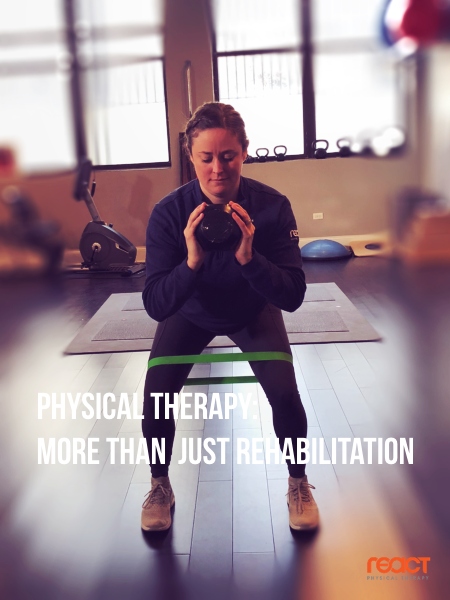Physical Therapy: More Than Just Rehabilitation

Many people have a misconstrued perception of what physical therapy is and when it is appropriate to seek care.
Physical therapy (PT) is often referred to as rehabilitation. However, rehabilitation is not the only benefit that physical therapy offers and it sometimes goes unacknowledged. Physical therapists are experts in movement of the body and can provide services for those far beyond the injured population.
So the question becomes…. Why would I seek out physical therapy if I am not injured or in pain?
Injuries are often a result of imbalances, restrictions, asymmetries, poor postural awareness and abnormal mechanics inhibiting movement that over time wreak havoc on one’s body. Even the smallest change or load placed on the musculoskeletal system (bones, muscle and connective tissue) can offset the foundation of movement, and without correction the support, stability and mobility of the human body can be negatively affected, leading to injury.
There is a good chance that you have not seen a physical therapist unless you were suffering from an injury. So, what if there was a way to prevent the injury prior to it occurring? This brings up the term Pre-rehabilitation or “Pre-hab.” This large component of physical therapy often receives little attention.
Preventative care or pre-rehabilitation can come in many forms, below are just 4 of those examples:
Prepare for the inevitable surgery
- This gives patients insight into what therapy will entail following the surgery. Focus will be on maintaining strength, mobility and flexibility within the body leading up to the surgery date. Preparing for the surgery allows for patients to seek information about how post-rehab will be directed and build a trusting relationship with the therapist.
Optimize movement and function in one’s body to promote health and wellness
- More of a preventative approach to therapy. Encourages patients to take control of their bodies while optimizing movement and function. Therapy will break down limitations and deficits within functional movement patterns and work to rebuild a strong foundation. Focus will be on building strength and balance in order to improve the ability to perform daily tasks and foster patient independence within the community.
Performance enhancement for athletes
- Preparing an athlete for sports competition by focusing on proper technique and body mechanics, which will help them avoid injury caused by physical stress placed on the body. Customized programs eliminate the risk of injury while incorporating sport-specific training in agility, strength and mechanics.
Fall risk/prevention
- Working with a population whose unsteady balance puts them at risk to fall. Focus is on building symmetry within the body and improving balance in order to prevent falls and increase independence.
The analogy that I like to use is that of the CHECK ENGINE LIGHT. Let me explain…
Anytime our “check engine light” comes on in our cars, we are quick to find answers as to what is happening, why it happened, and how to fix it. We often seek those answers as soon as possible. So why do we not acknowledge our own bodies “check engine light” the same way? The only difference I see in the two scenarios is that you can always trade-in your car if it breaks down on you, but we only have one body…So why are we so hesitant to listen and pay attention? Just as we take in our cars for routine tune-ups to prevent problems down the road (no pun intended), we should visit the body movement specialists for routine check-ups in order to prevent injuries.
Physical therapists have taken on a leadership role in body movement and preventative care. Through patient education, manual therapy, and therapeutic exercises physical therapists provide optimal care based on their knowledge of human anatomy and movement science.
So, if there is a way to prevent an inevitable injury before it sidelines you…why not see a physical therapist to address your balance, strength, posture, mobility, and flexibility to prepare you for the stresses placed throughout your body on a daily basis?